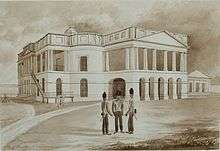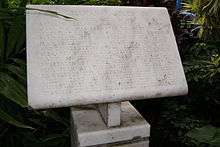George Drumgoole Coleman
George Drumgoole Coleman (1795 – 1844), also known as George Drumgold Coleman, was an Irish civil architect who played an instrumental role in the design and construction of much of the civil infrastructure in early Singapore, after it was founded by Sir Stamford Raffles in 1819.
Early life
Born in Drogheda, County Louth, Ireland, he was the son of James Coleman, a merchant, part of whose business was dealing in building materials.[1] Coleman was trained as a civil architect.
Career

In 1815, at the age of 19 years, he left Ireland for Calcutta, India, where he set up as an architect designing private houses for the merchants of Fort William.[2] In 1819, he was invited, through his patron John Palmer, to build two churches in Batavia in the Dutch East Indies. The churches were never built, but Coleman spent two years working in Java.[3]
Coleman then obtained an introduction to Sir Stamford Raffles from Palmer in Calcutta, and travelled to Singapore, arriving in June 1822. Coleman was responsible, as advisor to Raffles, for the draft layout of Singapore in 1822. He planned the centre of the town, created roads, and constructed many fine buildings. Raffles was away in Sumatra at the time, but Coleman also set about designing for him a residency house of timber with a thatched roof. On his return, Raffles approved the house, construction of which was begun in November of the same year, and he commissioned Coleman to design a garrison church.[4] However, the church was not built, and in June 1823 Coleman left for Java where he spent he next two and a half years, returning to Singapore in 1825.[5]
On his return to Singapore in 1825, he designed a large Palladian house for David Skene Napier, and a palatial building for the merchant John Argyle Maxwell, which before completion was leased to the government for use as a court house and government offices. Much altered and enlarged, it eventually formed part of the Parliament House of the Republic of Singapore. It was again in the Palladian manner, adapted to the tropical climate by incorporating a veranda and overhanging eaves to provide shade.[6]
Although Coleman designed numerous private houses in Singapore, only two certain to be designed by Coleman have survived in Singapore, the Parliament House (originally Maxwell's house, but has undergone considerable changes since), and Caldwell's House, now part of CHIJMES on Victoria Street. Another residence building, the Istana Kampong Glam, is believed to be by Coleman although there is no definite evidence.[7] Coleman's own house at 3 Coleman Street was demolished in December 1965 to make way for the current 21-storey Peninsula Hotel.
An outstanding example of his work that survives to this day is the Armenian Church of Saint Gregory the Illuminator on Hill Street, built in 1835. He also built the first Anglican church in Singapore, St Andrew's, which was begun in 1835, but this structure was demolished in the 1850s having become unsafe due to lightning strikes.[8] He was also hired to finish and extend the Raffles Institution, originally designed by Lieutenant Phillip. The building however was demolished in 1972.[9] Another prominent building of early Singapore designed by Coleman was the Telok Ayer market on the waterfront built in 1835. It was demolished due to land reclamation work in 1879 and the market was then moved to the present Lau Pa Sat, which retains the octagonal shape of the original market by Coleman.[10]
In 1833, Coleman was appointed the Superintendent of Public Works. He was also the surveyor and overseer of convict labour.
In 1841, Coleman left for England after 15 years of continuous work and 25 years in the East.
Personal life

On a return trip to in Ireland, Coleman married Maria Frances Vernon, of Clontarf Castle, Dublin.
Colman had a son, George Vernon Coleman, who was born 27 December 1843. He also had a daughter, Meda Elizabeth Coleman, born in Singapore on 10 March 1829 (or 1828) by an unknown woman, and was christened at St. Andrew's Cathedral on 30 July 1837. The mother is unlikely to have been Takoyee Manuk, the sister of Gvork Manuk, even though Coleman had built a mansion for her adjacent to his own.[11]
Coleman however found himself unable to settle down in Europe, and returned to Singapore with his bride in November 1843 at short notice. He took possession of another of his houses which stood at 1 and 2 Coleman Street.
Colman died on 25 March 1844 due to a fever, at the age of 49, soon after returning from Europe with his wife. He was buried in a cemetery at the foot of Bukit Larangan, now Fort Canning Hill. The impressive memorial over his mortal remains still stands at Fort Canning Park. After his death, Coleman's widow married attorney William Napier within months of her first husband's death. Napier adopted Coleman's infant son George. His daughter Meda died in Singapore in October 1907.
Legacy
George Drumgoole Coleman's name lives on in the following entities in Singapore:
- Coleman Bridge.
- Coleman Place.
- Coleman Street.
References
- ↑ Hancock (1986) pp. 2–6.
- ↑ Jane Beamish; Jane Ferguson (1 December 1985). A History of Singapore Architecture: The Making of a City. Graham Brash (Pte.) Ltd. p. 19. ISBN 978-9971947972.
- ↑ Hancock (1986) pp. 8–9.
- ↑ Hancock (1986) pp. 12–15.
- ↑ Hancock (1986) pp. 22.
- ↑ Hancock (1986) pp. 22–28.
- ↑ Jane Beamish; Jane Ferguson (1 December 1985). A History of Singapore Architecture: The Making of a City. Graham Brash (Pte.) Ltd. pp. 31–32. ISBN 978-9971947972.
- ↑ Hancock (1986) p. 75.
- ↑ "G. D. Coleman". Singapore Infopedia. National Library Board, Singapore.
- ↑ "Former Telok Ayer Market (now known as Lau Pa Sat)". Roots. National Heritage Board.
- ↑ (Wright 251-2)
Sources
| Wikimedia Commons has media related to George Drumgoole Coleman. |
- T.H.H. Hancock (1986), Coleman's Singapore, The Malaysian Branch of the Royal Asiatic Society in association with Pelanduk Publications.
- Lee Geok Boi (2002), The Religious Monuments of Singapore, Landmark Books, ISBN 981-3065-62-1.
- Victor R Savage, Brenda S A Yeoh (2003), Toponymics – A Study of Singapore Street Names, Eastern Universities Press, ISBN 981-210-205-1.
- Nadia Wright (2003), Respected Citizens: The History of Armenians in Singapore and Malaysia, Amassia Publishing. ISBN 0-9751082-0-4.